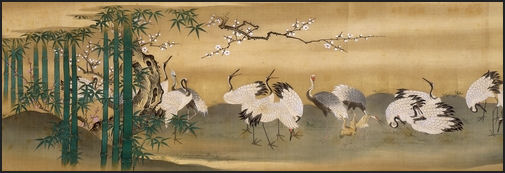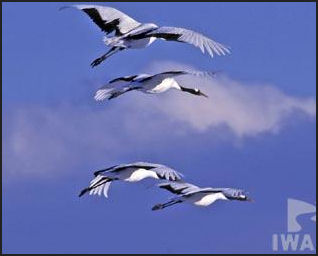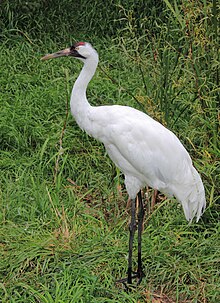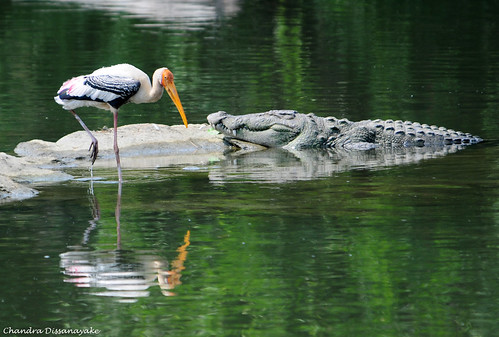Fascination with Crocodiles and Cranes provides the name and the content is along the lines of the beauty and the terror in Nature.
ESTUARY EXPERTS
ESTUARY EXPERTS
Sunday, January 29, 2012
Japanese Cranes and Japanese Culture
Cranes are symbols of love, happiness, martial fidelity and longevity in east Asia. They are common motifs on kimonos, scrolls, screens, porcelain, lacquerware, bronze mirrors and a popular brand of playing cards. Cranes also appear in Russian folk songs, ancient Egyptian tombs, Greek myths, Australian aboriginal dances, and prehistoric European cave art.
Jennifer Ackerman wrote in National Geographic, “The Japanese have written the tancho into poems and folktales and myths. They have painted it and made statues and sculptures to it...From its habits they have drawn phrases and metaphors to describe their own behavior. They have imitated it and tried to dance as it dances. They have named streets and cities after it. They have folded it into tiny birds of paper and hung them carefully in colored festoons at temples and shrines...Most of all they. They have made I into an icon and put its image everywhere, so this extremely rare bird is, ironically, seen throughout Japan."
The 17th century Japanese poet Basho wrote the following haiku:
Cool seascape with cranes
Wading long-legged in the pools
Amid the tideway dunes.
Cranes are the tallest and arguably the most elegant of all flying birds. More closely related to rails and bustards than herons, ibises and storks, they are known best for their unwavering faithfulness to mates, spectacular courtship displays, large size, long migrations and loud calls. Many species can reach a height of five feet within a year after they are born. Some of them have long life spans. One Siberian crane is known to have lived for 83 years.

 There are 15 species of crane. They generally make their homes in grasslands and wetlands. Nine species of crane are endangered. Some are near extinction. Their numbers have been reduced by hunting and habitat loss. Captive breeding programs have been set up in several countries to increase their numbers. At some of these places, cranes are raised by humans in crane costumes and taught to fly over grass runways with the help of ultralight planes flown by men in crane costumes.
There are 15 species of crane. They generally make their homes in grasslands and wetlands. Nine species of crane are endangered. Some are near extinction. Their numbers have been reduced by hunting and habitat loss. Captive breeding programs have been set up in several countries to increase their numbers. At some of these places, cranes are raised by humans in crane costumes and taught to fly over grass runways with the help of ultralight planes flown by men in crane costumes.  Crane pairs establish large breeding territories in wetlands and grasslands and zealously defend them. Intruders are warned off with a loud trumpeting. A pair builds a platform nest in shallow water. Typically two eggs are laid, with both sexes sharing incubation duties. After they hatch chicks remain with their parents until the next breeding season. In many cases only one chick survives. The low reproductive makes rebuilding decimated crane population a difficult task.
Crane pairs establish large breeding territories in wetlands and grasslands and zealously defend them. Intruders are warned off with a loud trumpeting. A pair builds a platform nest in shallow water. Typically two eggs are laid, with both sexes sharing incubation duties. After they hatch chicks remain with their parents until the next breeding season. In many cases only one chick survives. The low reproductive makes rebuilding decimated crane population a difficult task.
Migrating Cranes

 Some cranes in northern areas migrate thousands of kilometers between breeding and wintering areas. Unlike many other birds cranes are not born with the instinct to fly their migrations paths. Young are taught the route when they accompany their parents on the migration.
Some cranes in northern areas migrate thousands of kilometers between breeding and wintering areas. Unlike many other birds cranes are not born with the instinct to fly their migrations paths. Young are taught the route when they accompany their parents on the migration.  The distance covered by some migrating cranes is between a 1,000 miles and 3,000 miles. The fly over deserts, tundra and mountain ranges and rely on wetlands along the way to rest and replenish themselves. Cranes can sustain speeds of 30 mph by flying with flapping wings. They prefer to save energy by rising in n thermals and being carried by winds.
The distance covered by some migrating cranes is between a 1,000 miles and 3,000 miles. The fly over deserts, tundra and mountain ranges and rely on wetlands along the way to rest and replenish themselves. Cranes can sustain speeds of 30 mph by flying with flapping wings. They prefer to save energy by rising in n thermals and being carried by winds.  Some cranes know its time to breed based on seasonal markers such as day length and rainfall amounts. Demoiselle cranes can reach altitudes of 24,000 feet when they cross the Hindu Kush during their fall and spring migrations between nesting grounds in Central Asia and warmer, wintering areas in India.
Some cranes know its time to breed based on seasonal markers such as day length and rainfall amounts. Demoiselle cranes can reach altitudes of 24,000 feet when they cross the Hindu Kush during their fall and spring migrations between nesting grounds in Central Asia and warmer, wintering areas in India. Whopping cranes and Siberian cranes brought up in captive breeding programs are being taught to migrate by humans with ultra lights and hand gliders.
Whopping cranes and Siberian cranes brought up in captive breeding programs are being taught to migrate by humans with ultra lights and hand gliders.
Image Sources: 1) 2) British Museum 3) 4)Wolfgang Kaeler, International Wildlife Adventures 5) Hubpages blog 6) Nicolas Delerue 7) Japan-Animals blog
Text Sources: New York Times, Washington Post, Los Angeles Times, Daily Yomiuri, Times of London, Japan National Tourist Organization (JNTO), National Geographic, The New Yorker, Time, Newsweek, Reuters, AP, Lonely Planet Guides, Compton’s Encyclopedia and various books and other publications.
Dancing Cranes
Category: Film & Animation Tags: Cranes Japanese Cranes Chinese Painting Lucy Wang Dancing Cranes Animation
License: Standard YouTube License
Friday, January 27, 2012
Wednesday, January 25, 2012
Amateur Herpetologist Creates International Incident
BROWNSVILLE — Two things reptile enthusiast Karel Fortyn neglected to plan for when he smuggled two baby Orinoco crocodiles from Venezuela to Canada in 1986, by some accounts in a thermos.
One, that the extremely rare crocs would continue to grow in the incubator-like conditions he kept them in. And grow. Too large for any fishbowl, tub or other enclosure at his Welland, Ontario, serpentarium, so Fortyn eventually had to build a basement tank with a partition so the territory-starved male of the pair didn't kill the female.
And two, that he would die unexpectedly, launching a custody mess for hundreds of creatures he kept in his reptile zoo, including crocs Blade and Suede, two members of a critically endangered species Venezuela didn't want and northern zoos couldn't handle.
Enter Brownsville's Gladys Porter Zoo, which took on reams of paperwork to get past international endangered species guidelines and U.S. Customs and Border Protection port regulations to claim the 14-foot, 800-pound male, Blade, and the 11-foot, 400-pound female, Suede.
This weekend, zoo staffers traveled to Ontario with crocodile experts to extract the crocs from their prison-like tank and transport them to the tip of Texas in box trucks, anxious to avoid injuring them.
They arrived Wednesday, and used a crane to transfer the crates containing the crocs from a flatbed trailer to a new home designed just for them.
It took eight zoo staffers to secure the crates to the crane, another eight to meet them. Zoo Curator Colette H. Adams perched on the edge of the grotto, guiding the effort, then used a stick of bamboo to poke the giants out of their boxes.
A small crowd of onlookers cheered and applauded as Suede, and then Blade, emerged into a new world of fresh air and, though filtered by canopies, sunshine. Suede basked on her little shore, Blade slid right into the water. Both seemed to sport wide, toothy, crocodile grins.
“It's a pretty big deal. These are very rare crocodiles, very rare,” said Emma Mitchell, part of the zoo's education team. “I'm excited for the crocs. They get a beautiful place to live. I'm very excited for the species, and the zoo.”
Orinoco crocodiles are native to Venezuela and Colombia, but were all but wiped out because of their prized hides. Some estimate the wild population dipped to as few as 250 adults in the early 1990s. Stiff international protections and breeding efforts in their native South America have brought their total above 1,500, but they are still considered the most endangered New World crocodilian.
Blade and Suede's eventual offspring, if released in the wild, could prove a welcome addition to the gene pool.
Fortyn, who died of a stroke in May at age 52, did plan to build something larger, but fate got in the way, Adams said.
News clips from Canada detail the courtroom melodrama that went on between his former common-law wife, fiancée and brother, a Czech Republic resident who was finally given the legal right to make decisions about most of the reptiles. Most went to area zoos, but there was a quandary concerning the crocodiles.
An Internet petition to “Save the Orinoco Crocs of Seaway Serpentarium” garnered 271 signatures from all over the world.
“They were in a pen, 14 feet deep and 10 feet wide, divided in half,” Adams said. “They were indoors; they'd never to the best of my knowledge since the mid-1990s seen the sun. Their water was kept at approximately 80 degrees, and they did have a landing they could crawl out on. Though I never saw them crawl out on the landing.”
Suddenly, Adams breaks off in excitement to see Suede, who'd been in a box for days, move toward the water in the new 35-by-30-foot grotto.
“She's moving! She's moving!” she exclaimed.
Read more: http://www.mysanantonio.com/news/article/Happy-day-for-crocs-in-tri-national-saga-2227000.php#ixzz1kVhxdvvE
International Crane Foundation
Guadalupe River - International Crane Foundation

Both Whooping Cranes and blue crabs depend on the health of the Guadalupe River, which
feeds freshwater into the coastal marshes along the Gulf of Mexico. Photo by Mik
"On their wintering grounds along the Gulf Coast of Texas, Whooping Cranes feed almost exclusively on blue crabs (below). The coastal marshes provide excellent habitat for the crabs if salinity levels remain moderate, which is determined primarily by the amount of freshwater flowing into the coastal waters from the Guadalupe River basin.
When freshwater is reduced, due to drought or use of the river's water upstream, fewer crabs are available for Whooping Cranes. In such cases, the cranes weaken, resulting in higher mortality on their wintering grounds and fewer chicks on their breeding grounds in Canada the following spring. How will this affect the future of this endangered species?"
Source:http://www.savingcranes.org/guadalupe-river.html

Both Whooping Cranes and blue crabs depend on the health of the Guadalupe River, which
feeds freshwater into the coastal marshes along the Gulf of Mexico. Photo by Mik
"On their wintering grounds along the Gulf Coast of Texas, Whooping Cranes feed almost exclusively on blue crabs (below). The coastal marshes provide excellent habitat for the crabs if salinity levels remain moderate, which is determined primarily by the amount of freshwater flowing into the coastal waters from the Guadalupe River basin.
When freshwater is reduced, due to drought or use of the river's water upstream, fewer crabs are available for Whooping Cranes. In such cases, the cranes weaken, resulting in higher mortality on their wintering grounds and fewer chicks on their breeding grounds in Canada the following spring. How will this affect the future of this endangered species?"
Source:http://www.savingcranes.org/guadalupe-river.html
Whooping Cranes
The muskeg of the taiga in Wood Buffalo National Park, Alberta, Canada, and the surrounding area was the last remnant of the former nesting habitat of the Whooping Crane Summer Range. However, with the recent Whooping Crane Eastern Partnership Reintroduction Project, whooping cranes nested naturally for the first time in 100 years in the Necedah National Wildlife Refuge in Central Wisconsin, USA.
The whooping crane was declared endangered in 1967. Attempts have been made to establish other breeding populations in captivity. The whooping crane is endangered mainly as a result of habitat loss, although whoopers are also still illegally shot despite this being subject to substantial financial penalties and possible prison time.
At one time, the range for these birds extended throughout midwestern North America. In 1941, the wild population consisted of 21 birds. Conservation efforts have led to a population increase; as of April 2007 there were about 340 whooping cranes living in the wild, and another 145 living in captivity. The whooping crane is still one of the rarest birds in North America. The United States Fish and Wildlife Service confirmed that 266 whooping cranes made the migration to Aransas National Wildlife Refuge in 2007. In Wood Buffalo National Park, the Canadian Wildlife Service counted 73 mating pairs in 2007. They produced 80 chicks, of which 40 survived to the fall migration, and 39 completed the migration to Aransas National Wildlife Refuge.
The whooping crane was declared endangered in 1967. Attempts have been made to establish other breeding populations in captivity. The whooping crane is endangered mainly as a result of habitat loss, although whoopers are also still illegally shot despite this being subject to substantial financial penalties and possible prison time.
At one time, the range for these birds extended throughout midwestern North America. In 1941, the wild population consisted of 21 birds. Conservation efforts have led to a population increase; as of April 2007 there were about 340 whooping cranes living in the wild, and another 145 living in captivity. The whooping crane is still one of the rarest birds in North America. The United States Fish and Wildlife Service confirmed that 266 whooping cranes made the migration to Aransas National Wildlife Refuge in 2007. In Wood Buffalo National Park, the Canadian Wildlife Service counted 73 mating pairs in 2007. They produced 80 chicks, of which 40 survived to the fall migration, and 39 completed the migration to Aransas National Wildlife Refuge.
| Whooping Crane | |
|---|---|
 | |
| Conservation status | |
Linking Classrooms
THREE WHITE CRANES, TWO FLYWAYS, ONE WORLD
LINKING CLASSROOMS IN THE UNITED STATES, CHINA AND RUSSIA
The Three White Cranes project links classrooms along the flyways of three endangered cranes – the Siberian, Red-crowned and Whooping Cranes - through student camps, teacher exchanges and art.You are invited to post stories or comments to the Three White Cranes blog. Contact us for instructions on how to get started.
Three White Cranes Exhibit
LINKS
Visit our Three White Cranes website
http://www.trackingcranes.org/blog/labels/
International Childrens Exchange Foundation, Xianghai art club
Monday, January 16, 2012
Subscribe to:
Posts (Atom)











